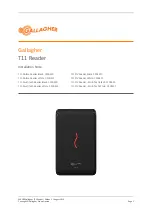
Bit 7 is the DLAB discussed earlier. It must be set to zero after the divisor is loaded or else there will be
no communications.
The C command to set the UART for an 8-bit word, no parity, and one stop bit is:
outportb(BA3, 0x03)
The final initialization step is to flush the receiver buffers. You do this with two reads from the receiver
buffer at Base A0. When done, the UART is ready to use.
Reception
Reception can be handled in two ways: polling and interrupt-driven. When polling, reception is
accomplished by constantly reading the Line Status Register at Base A5. Bit 0 of this register is
set high whenever data are ready to be read from the chip. A simple polling loop must continuously check
this bit and read in data as it becomes available. The following code fragment implements a polling loop
and uses a value of 13, (ASCII Carriage Return) as an end-of-transmission marker:
do
{
while (!(inportb(BA5) & 1));
/*Wait until data ready*/
data[i++]= inportb(BASEADDR);
}
while (data[i]!=13);
/*Reads the line until null character rec'd*/
Interrupt-driven communications should be used whenever possible and is required for high data rates.
Writing an interrupt-driven receiver is not much more complex than writing a polled receiver but care
should be taken when installing or removing your interrupt handler to avoid writing the wrong interrupt,
disabling the wrong interrupt, or turning interrupts off for too long a period.
The handler would first read the Interrupt Identification Register at Base A2. If the interrupt is for
Received Data Available, the handler then reads the data. If no interrupt is pending, control exits the
routine. A sample handler, written in C, is as follows:
readback = inportb(BA2);
if (readback & 4)
/*Readback will be set to 4 if data are available*/
data[i++]=inportb(BASEADDR);
outportb(0x20,0x20);
/*Write
EOI to 8259 Interrupt Controller*/
return;
Transmission
RS422 transmission is simple to implement. The AUTO feature of the card automatically enables the
transmitter when data is ready to send so no software enabling is required. The following software
example is for non-AUTO operation.
To transmit a string of data, the transmitter must first check Bit 5 of the Line Status Register at Base
A5. That bit is the transmitter-holding-register-empty flag. If it is high, the transmitter has sent the
data. The process of checking the bit until it goes high followed by a write is repeated until no data
remains.
Manual PCI-COM-422/4
16





































